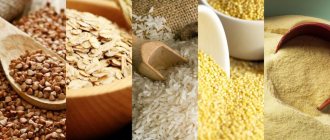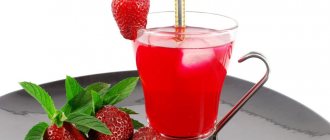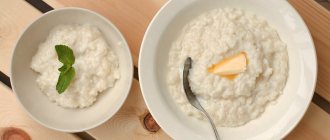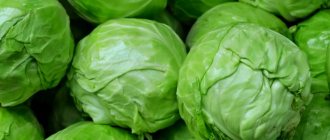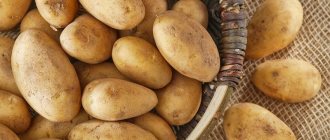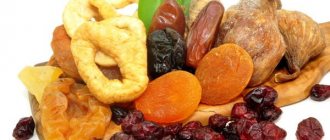Young mothers who breastfeed their children often argue about the benefits and harms of pork fat. Some parents believe that lard is one of the healthiest foods in the diet of children and adults, while others completely deny this. Often, nursing mothers avoid eating fatty foods only because they do not know about its beneficial properties. To understand this issue, you should find out how safe it is to consume lard during breastfeeding.
Useful properties of lard
Pork lard is one of the fattest foods in the modern human diet. Calorie content per 100g of pure product without marinade and spices: 810 kcal. In addition to fat, pork contains a large amount of vitamins C, D and E. The product is rich in potassium, sodium, magnesium, phosphorus, as well as many other useful micro- and macroelements.
Despite its high calorie content, pork fat is famous for its unique beneficial properties, namely:
- strengthens the immune system;
- increases the level of hemoglobin in the blood;
- normalizes the functioning of the cardiovascular system;
- stimulates the process of blood renewal in the body;
- participates in the development of bone tissue in children.
Side effects and contraindications
The main harm lies in the high fat content and high calorie content - 900 kcal per 100 g of product. Low-quality products can cause harm during breastfeeding. Rancid old fats are poisonous and may also contain heavy metal salts. Animals fed antibiotics accumulate these substances in their subcutaneous fat.
When expanding your diet with this product, you need to monitor your child’s reaction. Side effects may include indigestion, colic, flatulence, causeless crying, sleep disturbances, rashes, and breast refusal. At the slightest sign of intolerance, remove the product from the menu for at least 1 month.
Eating lard while breastfeeding is prohibited if:
- individual intolerance;
- acute form of diseases of the gastrointestinal tract, liver and kidneys;
- overweight;
- diabetes mellitus;
- disorders of cholesterol metabolism.
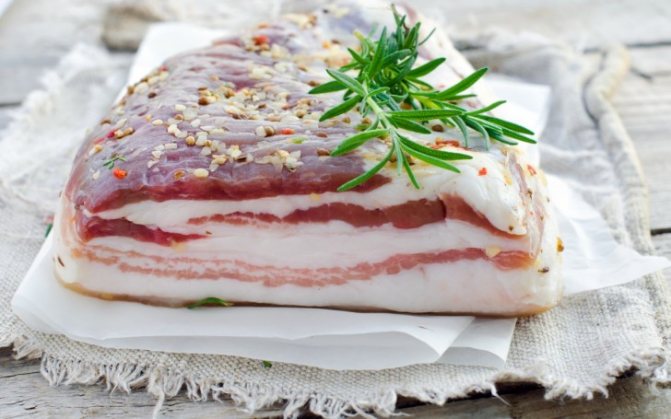
Lard may not always be beneficial for the body.
Harm of lard during breastfeeding
Pediatricians often face questions about whether a nursing mother can eat a fatty product and whether smoked lard will harm the baby during breastfeeding. Doctors strongly recommend following a strict diet in the first months after the baby is born and avoiding smoked, spicy and salted pork fat with spices and garlic. The list of foods that are undesirable to eat during breastfeeding also includes all types of smoked meats and fatty meats.
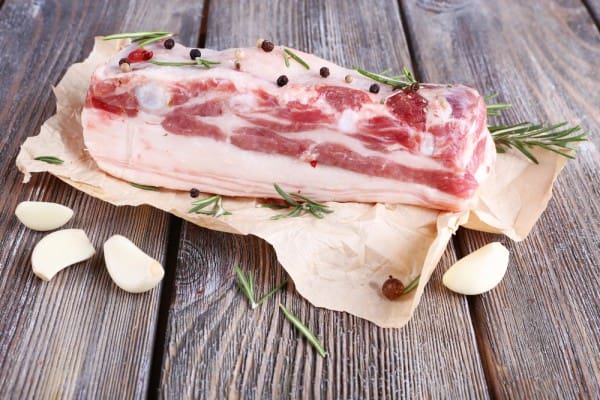
The fat layer of meat products contains a large amount of cholesterol, excessive consumption of which can cause serious heart and vascular diseases. Nursing mothers should be careful when consuming pork. The lack of enzymes for the absorption of fat in the baby’s body can provoke allergic reactions, intestinal colic, as well as sleep and digestive disorders in a small child.
How to add lard to your diet?
After six months, the baby’s digestive system becomes stronger and is able to digest different types of food. At the same time, a nursing woman gradually introduces more and more new foods into her diet. Especially if she used to be a fan of salted lard.
A nursing mother should closely monitor the health of her baby and, if a negative reaction occurs, refuse the new product.
Typically, allergic reactions appear within 2 days after its administration. This may include redness, rash, itching or swelling.
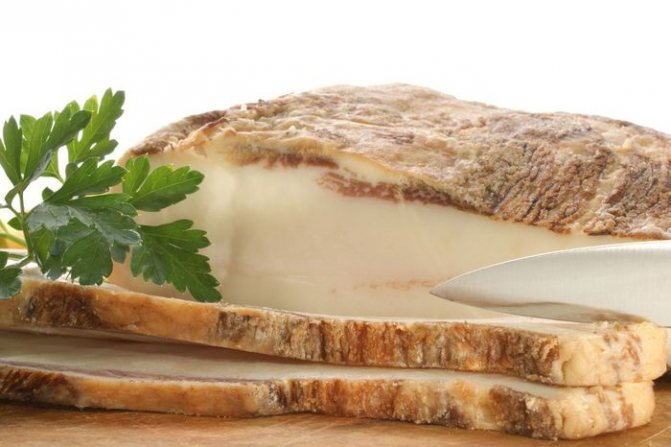
You should not immediately introduce 2 new foods into your diet, because it will be more difficult to determine what caused the allergic reaction. A woman should record everything in a food diary. This will make it easier to identify the allergenic product.
In the first 3 months, a nursing woman needs to limit the amount of fatty foods in her diet. This also applies to lard, which is introduced into the diet gradually.
Even if everything is fine with the child, you should also not overeat. The daily portion should not exceed 20 g. It is best to perceive such food as a delicacy that should appear in the diet periodically.
It is best to consume lard in the first half of the day. It can enhance the flow of bile, thereby helping to cleanse the body.
Recommendations for consuming lard during lactation
Despite the fact that the product has a high calorie content and seems quite fatty, its moderate consumption is allowed for women during the lactation period. Young mothers should remember the norms and restrictions on the consumption of animal fats during breastfeeding. In order not to harm the small body, a woman must follow medical recommendations for consuming lard during lactation:
- You can start eating pork only 6 months after the birth of the child, after consulting with your doctor.
- Fatty foods must be introduced into the diet gradually. The daily intake of lard for a nursing mother is no more than 20g, and the weekly intake is no more than 100g.
- During breastfeeding, you should avoid under-salted, fried, smoked and spicy types of delicacy. Consuming an improperly prepared product can negatively affect the baby's health.
- After the first attempt to eat a piece of lard, monitor your child’s reaction to a new fatty product. If within two days after consuming the product, animal fats do not have a negative effect on the baby’s health, you can safely continue to introduce it into the daily diet.
- It is necessary to buy the product only from trusted sellers, following all the rules for choosing quality lard.
Can a nursing mother eat lard?
Natural feeding requires limiting spicy, smoked, salty, and fatty foods in the menu. When deciding whether lard is suitable for a nursing mother, it is recommended to consult a pediatrician, since a baby may have special contraindications. In the absence of such, it is permissible to consume in small quantities after the child reaches a certain age. During lactation, a high concentration of saturated fats can cause digestive upset in a woman and baby.
On a note! Fresh lard should be excluded from the diet during breastfeeding. Treatment with salt or high temperature is detrimental to pathogens and helminth larvae and is therefore necessary to ensure product safety.
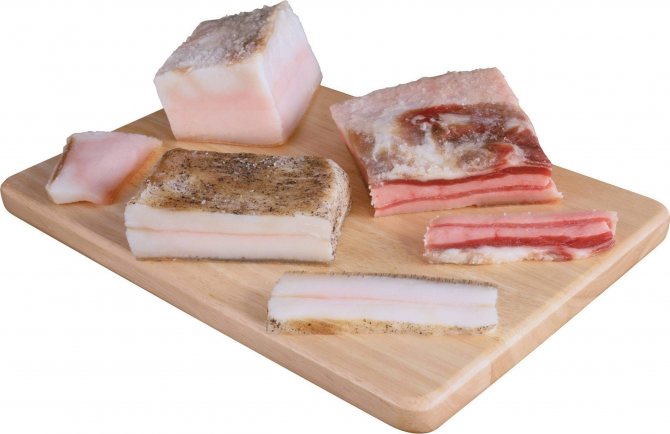
The decision to consume lard during breastfeeding should be made only after consultation with a doctor.
Salted or smoked?
During the period of natural feeding, it is permissible to add a little salted lard, prepared by dry method or cooking, to the diet. In addition to fat, smoked meats contain a large amount of extractive substances that can cause gastrointestinal problems and an allergic reaction in the baby. It is recommended to avoid such foods during lactation to prevent colic and flatulence. When the baby grows up and begins to eat mainly complementary foods, it is permissible in rare cases to eat a small piece if the mother really wants it.
On a note! There should be no meat layers in the lard, since they are often a source of human infection with various bacteria, which is especially dangerous during breastfeeding.
Ban on eating lard in the first six months of a child’s life
Breastfeeding women should abstain from the product until the baby is 6-7 months old. This is explained by the fact that the child’s body is not ready for heavy food; the digestive system continues to develop. The absence of many enzymes and beneficial microflora in the intestines complicates the process of digesting food.
Dense, refractory fats during breastfeeding are difficult for the body of a nursing woman to digest, not to mention the baby. Premature or excessive intake of them with food causes nausea, regurgitation, and abdominal pain. Poor nutrition is a common cause of gastrointestinal diseases in the future.
How to choose and what to pay attention to?
When choosing pork, a young mother should be especially careful. Unscrupulous suppliers may hide the fact that they fed the pig hormonal drugs, growth stimulants or antibiotics to increase carcass weight. Fresh and high-quality lard can be identified by primary characteristics, namely:
Origin
The first thing a young mother should pay attention to is where she purchased the product. It is best to buy it on the market, where all laboratory examinations and analyzes of the products sold are carried out. When you are sure that the product is certified and not hazardous to health, ask the seller what kind of lard he sells: from pig or wild boar? The greasy layer of a young pig has a delicate taste and is more suitable for young mothers during breastfeeding.
For additional verification, let the seller know whether this lard can be eaten while breastfeeding and whether the product will harm a small child? A conscientious seller will never sell a nursing mother a product of which he is not sure of the quality.
Appearance
To distinguish young lard from old, just look at the color of the fat layer. Fresh product should not have any traces of blood or yellow or gray stains. The fat of a healthy young pig is always a soft pink or white hue.
Smell
If the product on the counter is of high quality, then its smell is pleasant and does not cause disgust. To finally ensure the freshness of the purchased product, ask the seller to set fire to a small piece using a lighter or matches. The fat layer of the wild boar has a pronounced unpleasant rotten odor.
Texture
Young lard has a thin skin without bristles and hairs. The thicker the skin, the older the pig was. With age, pig fat acquires a bitter taste and loses its beneficial properties. Its use is extremely undesirable for young mothers with breastfeeding. Also, you should not eat lard with meat layer. Meat that cannot be cooked can be contaminated with bacteria and various infections. Most pathogenic bacteria cannot exist and multiply in pure pork fat, so it is safer for the health of the baby and his mother.
Taste
To the question whether nursing women can buy pre-salted lard, there is a clear answer: it is possible, but not advisable. The healthiest product is considered to be pure pork fat without salt and spices. If the product on the counter is fresh, the taste of the pork will be tender, pleasant and without bitterness.
In order not to risk your baby’s health, prepare purchased pure lard without spices and marinade yourself at home. This method of preparation is the safest for a small organism.
What kind of lard can a nursing mother
Of course, in the first months you should still refrain from such a delicacy. It is believed that the baby's gastrointestinal tract adjusts to normal functioning in the initial three months. The strictest diet should be followed only for the first month. Next, you can begin to introduce various foods familiar to the mother. At the same time, carefully observe the baby’s reaction. If he is comfortable and no allergic reaction has occurred, then he can continue to eat the new product.

Lard is introduced in the same way. The piece should be small (2x2 cm maximum) and is best served with bread. Eat the product in the morning so that you can see the results by the evening, not at night.
The lard must be of high quality. Therefore, when buying it, be sure to pay attention to whether there is a seal on the skin. In addition, you can request a certificate and information from the seller. The lard itself should be soft, slightly moist, the skin should come off easily and can be pierced with a match. In this case, a milky smell and a white-pink color are required. If there are any doubts about the quality of the product, then it is better to refuse the purchase.
For the same reason, it is better to salt lard yourself than to buy ready-made lard. After all, some unscrupulous manufacturers salt an already spoiled product, masking its smell with various spices and flavorings. Also, during lactation, smoked foods and foods with a lot of spices are prohibited. But after 6-8 months you can try them. But this is only if the child’s digestive system is normal.

So, here is a table of approximate ages for introducing different types of lard into the diet of a nursing mother:
| Type of lard | Child's age | Note |
| Homemade salty | 2-3 months | If there are no problems such as frequent bloating, constipation, or increased gas formation. |
| Store-bought salted | 3-4 months | |
| Salty with garlic | 5-6 months | Some children do not like the taste of garlic in milk. |
| Smoked | 6-8 months | You also need to try it with caution and monitor the reaction. |
| With various spices | 11-12 months | In this case, it is possible only if the child is not allergic. Otherwise, rashes may occur. |
| Raw | 12-15 months | Even if you have all the certificates, it is impossible to be 100% sure of the quality, so you should not risk your health. |
| Roast | 12-15 months | It contains a large amount of fat, which is not particularly desirable when breastfeeding. |
Homemade recipes
A young mother should remember that pork fat loses all its beneficial properties after heat treatment. To preserve the benefits of eating lard, salt a piece of pork yourself, instead of buying a “pig in a poke” at the market. To prepare a tasty and healthy delicacy, use two salting methods:
Wet
To prepare lard using the wet salting method, dilute 2 cups of table salt in 1.5 liters of warm water. Cut the pork into 10 cm pieces in advance and place on the bottom of a deep pan. Fill the container with the prepared brine so that the liquid completely covers the pieces of lard. Leave the pan in a dark, cool place for 48 hours to allow the pork fat to absorb enough salt. After the time has passed, remove the finished salty delicacy from the brine and place in a dry bowl. Store the product on the refrigerator shelf for no longer than 20 days.
Dry
To prepare lard using the dry salting method, cut it into large pieces and roll in coarse table salt. Transfer the pork to any convenient container, cover and refrigerate for 36 hours. If the fat is not salted enough, leave it for another 24 hours and try again. The product must be stored after removing any remaining salt for no longer than two weeks in the refrigerator and no longer than four weeks in the freezer.
Rules for choosing lard
Women need to pay attention to the quality of the product. The following points need to be taken into account:
- The meat product must bear the stamp of the veterinary service.
- It is best to buy lard from a trusted seller.
- The color of the product should be pale pink. A yellow, and even more so a gray tint is one of the signs of stale lard.
- A quality product should have a sweet and milky aroma.
- The optimal thickness of a piece is 2-3 cm. It is best if the lard comes from the abdominal part, so it will be tastier.
- A good quality product will feel damp but not slippery.
- The lard skin should be smooth and soft to the touch.

All these nuances must be taken into account in order to choose high-quality and tasty lard.
The benefits of lard
Experts consider the product relatively useful. Due to the large amount of fat in it, lard is difficult for the body to digest. However, thanks to its beneficial composition, its components have benefits for the newborn’s body:
- Vitamin D. It is especially important for infants because it strengthens the skeletal system and prevents the development of rickets. The product contains the same amount of vitamin D as butter. True, the latter also contains cholesterol.
- Vitamin A. Responsible for the normal condition of mucous membranes, prevents eye diseases and moisturizes the skin.
- Vitamin E. Strengthens blood vessels, stabilizes cholesterol levels and has a positive effect on the condition of the skin. Vitamin E is important for women; it maintains hormonal levels in the right state.
- Arachidonic acid. It is necessary for the functioning of the heart and has a positive effect on mental activity.
Composition and benefits of lard during breastfeeding

Lard has a number of beneficial properties
Nutritionists and pediatricians pay great attention to lard, because despite its apparent harmfulness and high calorie content (724–902 kcal per 100 grams), it contains useful micro- and macroelements, such as iron, zinc, copper, phosphorus, selenium and manganese, which have a beneficial effect on the body. Lard also contains vitamins A, D, E and F. It is also rich in fatty acids - stearic, linoleic, palmitic, oleic, arachidonic (0.5%).
Energy value of lard (approximate ratio per 100 grams of product)
- Proteins - 2.4 g.
- Fats - 89.0 g.
- Carbohydrates - 0.0 g.
Beneficial properties of pork lard
- The vitamins contained in lard have a positive effect on the skin and hair, increase visual acuity, strengthen the immune system, and normalize hormonal levels.
- Lecithin contained in pork fat strengthens blood vessels.
- Lard has much less cholesterol than butter, and its bioactivity is 5–6 times higher.
- This product melts at a temperature of 37°C, which is close to the temperature of the human body and satiation from it occurs faster, after just a few pieces.
- Equally important is the content of arachidonic acid in lard, which can dissolve carcinogens and remove toxins from the body, preventing the development of cancerous tumors. Among other things, this polyunsaturated fatty acid is part of the building blocks of the membranes of the brain and retina. A nursing mother passes arachidonic acid to her baby through breast milk, thereby ensuring the protection of the small organism from the effects of harmful substances and the full development of its nervous system.
The increased need for arachidonic and docosahexaenoic acids in children of the first year of life is due to the rapid growth of the brain, the weight of which increases 3 times in the first year of life. Maternal breast milk, along with essential fatty acids - linoleic and linolenic, also contains arachidonic and docosahexaenoic acids in amounts of 0.3–0.6% and 0.1–1.4%, respectively.
Horse I.Ya. and etc.; Handbook of Functional Gastroenterology
https://www.gastroscan.ru/handbook/396/8599
How to choose the right lard
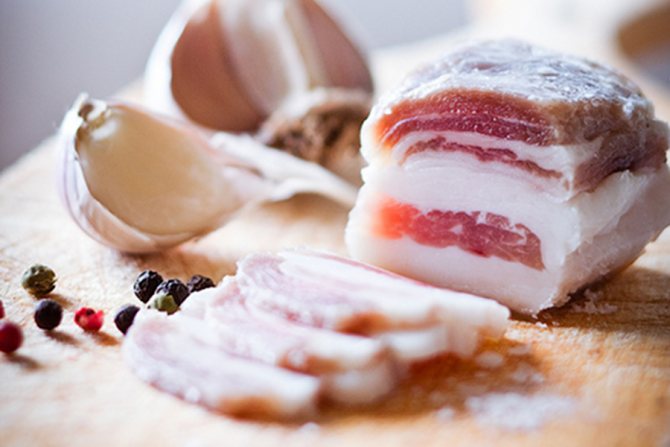
The taste and softness of prepared lard directly depends on the correct choice of fresh product.
When purchasing this Ukrainian delicacy in a store or market, you should make sure not only of the freshness of the product, but also ask the seller if all the necessary sanitary documents are available. Fresh lard is always white or with a slight pinkish tint, and has no smell of urea or other foreign odors. If a clear reddish tint or vascular veins are noticeable, then you should refuse to purchase such a product. Blood could get into the lard for a number of reasons; in any case, the taste will be far from ideal. If the product has a yellow or gray tint, most likely it is not fresh and a nursing mother should definitely not consume such a delicacy. The skin should be without bristles, but its color can be anything from white or light yellow to brown. The principle also applies - the thinner the skin, the softer the fat. As for the thickness of the pieces, you should give preference to layers of the product 3–6 centimeters thick.
It is advisable to try to pierce the lard; usually sellers have special knives or forks for this. Fresh product is pierced easily, with little resistance. When purchasing this delicacy for a nursing mother, you should not give up the opportunity to taste a small piece; it should be easy to chew, literally melt in your mouth.
In order for the lard to be tasty and tender after cooking, you need to pay attention to which part of the pig it is purchased from . For a nursing mother, it is better to choose pieces from the back or side, they are best suited for salting, they will be more tender and soft, belly fat is also suitable, although when salted it may be a little tougher, but it has streaks of meat, which will give a special taste to the delicacy.
